VEGFR2 regulates endothelial differentiation of colon cancer cells
- PMID: 28854900
- PMCID: PMC5577671
- DOI: 10.1186/s12885-017-3578-9
VEGFR2 regulates endothelial differentiation of colon cancer cells
Abstract
Background: Recent studies suggested that cancer stem-like cells contribute to tumor vasculogenesis by differentiating into endothelial cells. However, such process is governed by still undefined mechanism.
Methods: At varying differentiation levels, three representative colon cancer cells were cultured in endothelial-inducing conditioned medium: human colon cancer cells HCT116 (HCT116) (poorly differentiated), SW480 (moderately differentiated), and HT29 (well differentiated). We tested for expression of endothelial markers (cluster of differentiation (CD) 31, CD34, and vascular endothelial (VE)-cadherin and their ability to form tube-like structures in 3D culture. We also observed VEGF secretion and expressions of endothelial markers and VEGFRs in HCT116 cells under hypoxia to simulate physiological conditions. In in vitro and in xenotransplantation experiments, VE growth factor receptor 2 (VEGFR2) antagonist SKLB1002 was used to test effect of VEGFR2 in endothelial differentiation of HCT116 cells. Expression levels of VEGFR2 and VE-cadherin were assessed by immunohistochemistry of human colon cancer tissues to evaluate clinicopathological significance of VEGFR2.
Results: After culturing in endothelial-inducing conditioned medium, poorly differentiated HCT116 cells expressed endothelial markers and formed tube-like structure in vitro. HCT116 cells secreted more endogenous VEGF and expressed higher VEGFR2 under hypoxia. SKLB1002 impaired endothelial differentiation in vitro and xenotransplantation experiments, suggesting a VEGFR2-dependent mechanism. Increased expression of VEGFR2 correlated with differentiation, metastasis/recurrence, and poor prognosis in 203 human colon cancer samples. Positive correlation was observed between VEGFR2 and VE-cadherin expression.
Conclusions: VEGFR2 regulates endothelial differentiation of colon cancer cell and may be potential platform for anti-angiogenesis cancer therapy.
Keywords: Colon cancer; VE-cadherin; VEGFR2; Vasculogenesis.
Conflict of interest statement
Ethics approval and consent to participate
This study was approved by the Ethics Committee of Tianjin Medical University Cancer Institute and Hospital, and written informed consent was obtained from all participants. All animal experiments have been approved by Ethics Committee on animal experiments of Tianjin Medical University Cancer Institute and Hospital.
Consent for publication
Not applicable
Competing interests
The authors declare that they have no competing interests.
Publisher’s Note
Springer Nature remains neutral with regard to jurisdictional claims in published maps and institutional affiliations.
Figures
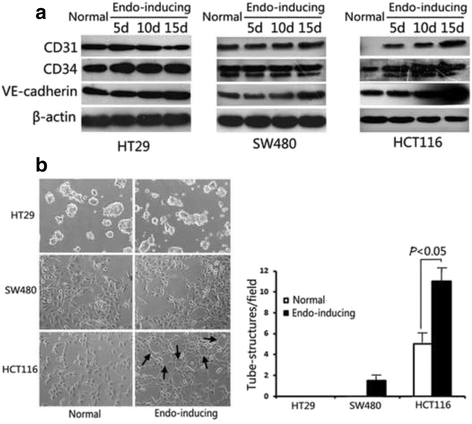
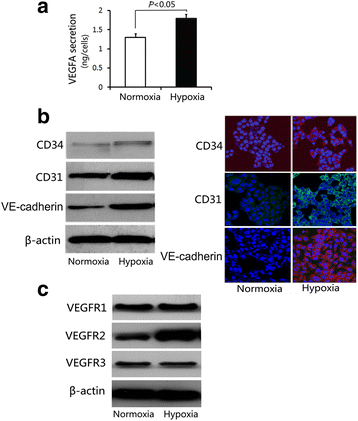
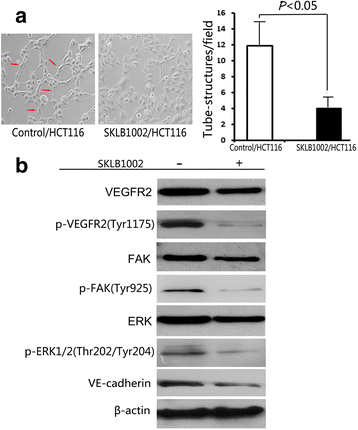
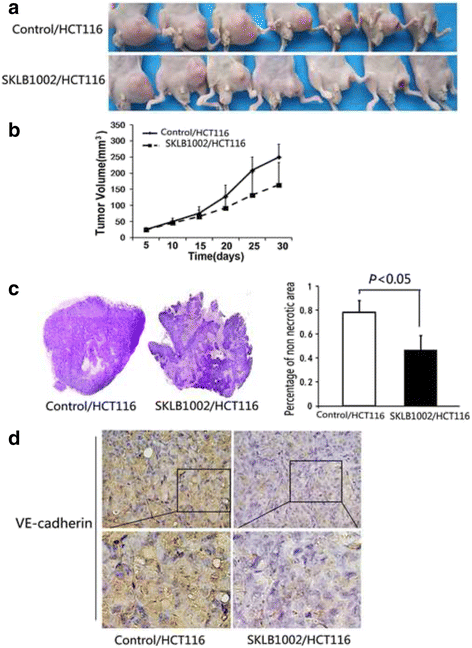
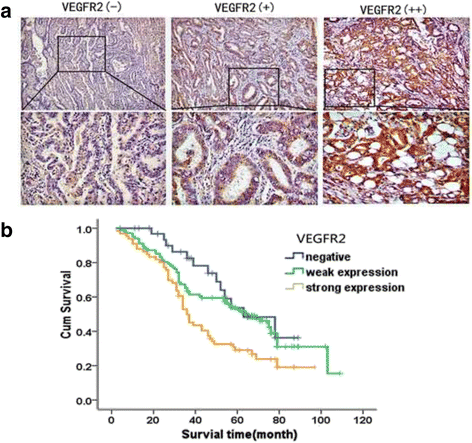
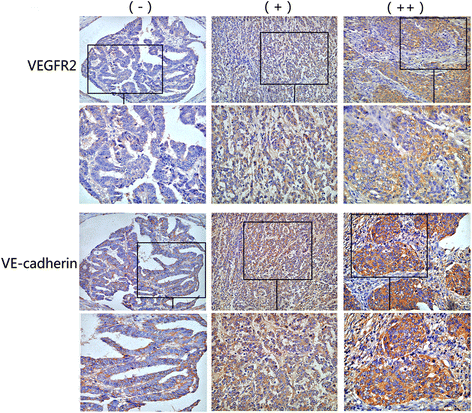
Similar articles
-
Vascular endothelial-cadherin stimulates syndecan-1-coupled insulin-like growth factor-1 receptor and cross-talk between αVβ3 integrin and vascular endothelial growth factor receptor 2 at the onset of endothelial cell dissemination during angiogenesis.FEBS J. 2013 May;280(10):2194-206. doi: 10.1111/febs.12134. Epub 2013 Feb 11. FEBS J. 2013. PMID: 23331867 Free PMC article.
-
Vascular endothelial growth factor signaling in VE-cadherin expression and tube-like formation by rheumatoid arthritic synovial fibroblast-like cells.Biochem Biophys Res Commun. 2019 Jan 8;508(2):405-409. doi: 10.1016/j.bbrc.2018.11.116. Epub 2018 Nov 28. Biochem Biophys Res Commun. 2019. PMID: 30503342
-
Glucose-regulated protein 78 silencing down-regulates vascular endothelial growth factor/vascular endothelial growth factor receptor 2 pathway to suppress human colon cancer tumor growth.J Surg Res. 2013 Nov;185(1):264-72. doi: 10.1016/j.jss.2013.05.020. Epub 2013 May 29. J Surg Res. 2013. PMID: 23759331
-
Vasculogenic mimicry signaling revisited: focus on non-vascular VE-cadherin.Mol Cancer. 2017 Mar 21;16(1):65. doi: 10.1186/s12943-017-0631-x. Mol Cancer. 2017. PMID: 28320399 Free PMC article. Review.
-
In Development-A New Paradigm for Understanding Vascular Disease.J Cardiovasc Pharmacol. 2017 May;69(5):248-263. doi: 10.1097/FJC.0000000000000480. J Cardiovasc Pharmacol. 2017. PMID: 28328747 Free PMC article. Review.
Cited by
-
Dual Targeting of Endothelial and Cancer Cells Potentiates In Vitro Nanobody-Targeted Photodynamic Therapy.Cancers (Basel). 2020 Sep 23;12(10):2732. doi: 10.3390/cancers12102732. Cancers (Basel). 2020. PMID: 32977602 Free PMC article.
-
Case report: Post-therapeutic laryngeal carcinoma patient possessing a high ratio of aneuploid CTECs to CTCs rapidly developed de novo malignancy in pancreas.Front Oncol. 2022 Sep 12;12:981907. doi: 10.3389/fonc.2022.981907. eCollection 2022. Front Oncol. 2022. PMID: 36172149 Free PMC article.
-
A zebrafish HCT116 xenograft model to predict anandamide outcomes on colorectal cancer.Cell Death Dis. 2022 Dec 23;13(12):1069. doi: 10.1038/s41419-022-05523-z. Cell Death Dis. 2022. PMID: 36564370 Free PMC article.
-
Aneuploid Circulating Tumor-Derived Endothelial Cell (CTEC): A Novel Versatile Player in Tumor Neovascularization and Cancer Metastasis.Cells. 2020 Jun 24;9(6):1539. doi: 10.3390/cells9061539. Cells. 2020. PMID: 32599893 Free PMC article. Review.
-
Endothelial cells in colorectal cancer.World J Gastrointest Oncol. 2019 Nov 15;11(11):946-956. doi: 10.4251/wjgo.v11.i11.946. World J Gastrointest Oncol. 2019. PMID: 31798776 Free PMC article. Review.
References
MeSH terms
Substances
LinkOut - more resources
Full Text Sources
Other Literature Sources

